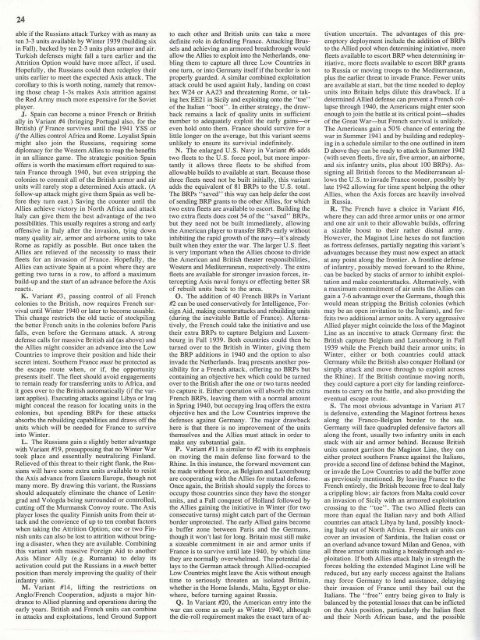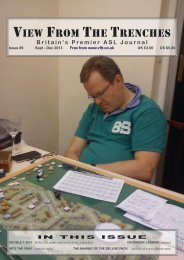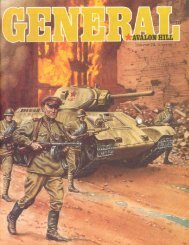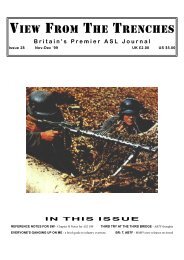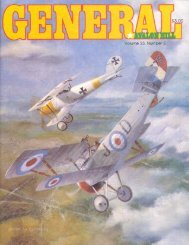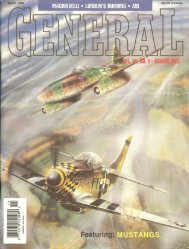general - View From The Trenches
general - View From The Trenches
general - View From The Trenches
- TAGS
- trenches
- www.vftt.co.uk
You also want an ePaper? Increase the reach of your titles
YUMPU automatically turns print PDFs into web optimized ePapers that Google loves.
24<br />
able if the Russians attack Turkey with as many as<br />
ten 3-3 units available by Winter 1939 (building six<br />
in Fall), backed by ten 2-3 units plus armor and air.<br />
Turkish defenses might fall a turn earlier and the<br />
Attrition Option would have more affect, if used.<br />
Hopefully, the Russians could then redeploy their<br />
units earlier to meet the expected Axis attack. <strong>The</strong><br />
corollary to this is worth noting, namely that removing<br />
those cheap 1-3s makes Axis attrition against<br />
the Red Army much more expensive for the Soviet<br />
player.<br />
J. Spain can become a minor French or British<br />
ally in Variant #4 (bringing Portugal also, for the<br />
British) if France survives until the 1941 YSS or<br />
ifthe Allies control Africa and Rome. Loyalist Spain<br />
might also join the Russians, requiring some<br />
diplomacy for the Western Allies to reap the benefits<br />
in an alliance game. <strong>The</strong> strategic position Spain<br />
offers is worth the maximum effort required to sustain<br />
France through 1940, but even stripping the<br />
colonies to commit all of the British armor and air<br />
units will rarely stop a determined Axis attack. (A<br />
follow-up attack might give them Spain as well before<br />
they turn east.) Saving the counter until the<br />
Allies achieve victory in North Africa and attack<br />
Italy can give them the best advantage of the two<br />
possibilities. This usually requires a strong and early<br />
offensive in Italy after the invasion, tying down<br />
many quality air, armor and airborne units to take<br />
Rome as rapidly as possible. But once taken the<br />
Allies are relieved of the necessity to mass their<br />
fleets for an invasion of France. Hopefully, the<br />
Allies can activate Spain at a point where they are<br />
getting two turns in a row, to afford a maximum<br />
build-up and the start ofan advance before the Axis<br />
reacts.<br />
K. Variant #3, passing control of all French<br />
colonies to the British, now requires French survival<br />
until Winter 1940 or later to become usuable.<br />
This change restricts the old tactic of stockpiling<br />
the better French units in the colonies before Paris<br />
falls, even before the Germans attack. A strong<br />
defense calls for massive British aid (as above) and<br />
the Allies might consider an advance into the Low<br />
Countries to improve their position and hide their<br />
secret intent. Southern France must be protected as<br />
the escape route when, or if, the opportunity<br />
presents itself. <strong>The</strong> fleet should avoid engagements<br />
to remain ready for transferring units to Africa, and<br />
it goes over to the British automatically (if the variant<br />
applies). Executing attacks against Libya or Iraq<br />
might conceal the reason for locating units in the<br />
colonies, but spending BRPs for these attacks<br />
absorbs the rebuilding capabilities and draws off the<br />
units which will be needed for France to survive<br />
into Winter.<br />
L. <strong>The</strong> Russians gain a slightly better advantage<br />
with Variant #19, presupposing that no Winter War<br />
took place and essentially neutralizing Finland.<br />
Relieved of this threat to their right flank, the Russians<br />
will have some extra units available to resist<br />
the Axis advance from Eastern Europe, though not<br />
many more. By drawing this variant, the Russians<br />
should adequately eliminate the chance of Leningrad<br />
and Vologda being surrounded or controlled,<br />
cutting off the Murmansk Convoy route. <strong>The</strong> Axis<br />
player loses the quality Finnish units from their attack<br />
and the convience of up to ten combat factors<br />
when taking the Attrition Option; one or two Finnish<br />
units can also be lost to attrition without bringing<br />
a disaster, when they are available. Combining<br />
this variant with massive Foreign Aid to another<br />
Axis Minor Ally (e.g. Rumania) to delay its<br />
activation could put the Russians in a much better<br />
position than merely improving the quality of their<br />
infantry units.<br />
M. Variant #14, lifting the restrictions on<br />
Anglo/French Cooperation, adjusts a major hindrance<br />
to Allied planning and operations during the<br />
early years. British and French units can combine<br />
in attacks and exploitations, lend Ground Support<br />
to each other and British units can take a more<br />
definite role in defending France. Attacking Brussels<br />
and achieving an armored breakthrough would<br />
allow the Allies to exploit into the Netherlands, enabling<br />
them to capture all three Low Countries in<br />
one turn, or into Germany itself if the border is not<br />
properly guarded. A similar combined exploitation<br />
attack could be used againt Italy, landing on coast<br />
hex W24 or AA23 and threatening Rome, or taking<br />
hex EE21 in Sicily and exploiting onto the "toe"<br />
of the Italian "boot". In either strategy, the drawback<br />
remains a lack of quality units in sufficient<br />
number to adequately exploit the early gains-or<br />
even hold onto them. France should survive for a<br />
little longer on the average, but this variant seems<br />
unlikely to ensure its survivial indefinitely.<br />
N. <strong>The</strong> enlarged U.S. Navy in Variant #6 adds<br />
two fleets to the U.S. force pool, but more importantly<br />
it allows three fleets to be shifted from<br />
allowable builds to available at start. Because those<br />
three fleets need not be built initially, this variant<br />
adds the equivalent of 81 BRPs to the U.S. total.<br />
<strong>The</strong> BRPs "saved" this way can help defer the cost<br />
of sending BRP grants to the other Allies, for which<br />
two extra fleets are available to escort. Building the<br />
two extra fleets does cost 54 of the "saved" BRPs,<br />
but they need not be built immediately, allowing<br />
the American player to transfer BRPs early without<br />
inhibiting the rapid growth of the navy-it's already<br />
built when they enter the war. <strong>The</strong> larger U. S. fleet<br />
is very important when the Allies choose to divide<br />
the American and British theater responsibilities,<br />
Western and Mediterranean, respectively. <strong>The</strong> extra<br />
fleets are available for stronger invasion forces, intercepting<br />
Axis naval forays or effecting better SR<br />
of rebuilt units back to the area.<br />
O. <strong>The</strong> addition of 40 French BRPs in Variant<br />
#2 can be used conservatively for Intelligence, Foreign<br />
Aid, making counterattacks and rebuilding units<br />
(during the inevitable Battle of France). Alternatively,<br />
the French could take the initiative and use<br />
their extra BRPs to capture Belgium and Luxembourg<br />
in Fall 1939. Both countries could then be<br />
turned over to the British in Winter, giving them<br />
the BRP additions in 1940 and the option to also<br />
invade the Netherlands. Iraq presents another possibility<br />
for a French attack, offering no BRPs but<br />
containing an objective hex which could be turned<br />
over to the British after the one or two turns needed<br />
to capture it. Either operation will absorb the extra<br />
French BRPs, leaving them with a normal amount<br />
in Spring 1940, but occupying Iraq offers the extra<br />
objective hex and the Low Countries improve the<br />
defenses against Germany. <strong>The</strong> major drawback<br />
here is that there is no improvement of the units<br />
themselves and the Allies must attack in order to<br />
make any substantial gain.<br />
P. Variant #11 is similar to #2 with its emphasis<br />
on moving the main defense line forward to the<br />
Rhine. In this instance, the forward movement can<br />
be made without force, as Belgium and Luxembourg<br />
are cooperating with the Allies for mutual defense.<br />
Once again, the British should supply the forces to<br />
occupy those countries since they have the stonger<br />
units, and a Fall conquest of Holland followed by<br />
the Allies gaining the initiative in Winter (for two<br />
consecutive turns) might catch part of the German<br />
border unprotected. <strong>The</strong> early Allied gains become<br />
a buffer zone between Paris and the Germans,<br />
though it won't last for long. Britain must still make<br />
a sizeable commitment in air and armor units if<br />
France is to survive until late 1940, by which time<br />
they are normally overwhelmed. <strong>The</strong> potential delays<br />
to the German attack through Allied-occupied<br />
Low Countries might leave the Axis without enough<br />
time to seriously threaten an isolated Britain,<br />
whether in the Home Islands, Malta, Egypt or elsewhere,<br />
before turning against Russia.<br />
Q. In Variant #20, the American entry into the<br />
war can come as early as Winter 1940, although<br />
the die-roll requirement makes the exact turn of ac-<br />
tivation uncertain. <strong>The</strong> advantages of this preemptory<br />
deployment include the addition of BRPs<br />
to the Allied pool when determining initiative, more<br />
fleets available to escort BRP when determining initiative,<br />
more fleets available to escort BRP grants<br />
to Russia or moving troops to the Mediterranean,<br />
plus the earlier threat to invade France. Fewer units<br />
are available at start, but the time needed to deploy<br />
units into Britain helps dilute this drawback. If a<br />
determined Allied defense can prevent a French collapse<br />
through 1940, the Americans might enter soon<br />
enough to join the battle at its critical point-shades<br />
of the Great War-but French survival is unlikely.<br />
<strong>The</strong> Americans gain a 50% chance of entering the<br />
war in Summer 1941 and by building and redeploying<br />
in a schedule similar to the one outlined in item<br />
D above they can be ready to attack in Summer 1942<br />
(with seven fleets, five air, five armor, an airborne,<br />
and six infantry units, plus about 100 BRPs). Assigning<br />
all British forces to the Mediterranean allows<br />
the U.S. to invade France sooner, possibly by<br />
late 1942 allowing for time spent helping the other<br />
Allies, when the Axis forces are heavily involved<br />
in Russia.<br />
R. <strong>The</strong> French have a choice in Variant #16,<br />
where they can add three armor units or one armor<br />
and one air unit to their allowable builds, offering<br />
a sizable boost to their rather dismal army.<br />
However, the Maginot Line hexes do not function<br />
as fortress defenses, partially negating this variant's<br />
advantages because they must now expect an attack<br />
at any point along the frontier. A frontline defense<br />
of infantry, possibly moved forward to the Rhine,<br />
, can be backed by stacks of armor to inhibit exploitation<br />
and make counterattacks. Alternatively, with<br />
a maximum commitment of air units the Allies can<br />
gain a 7-6 advantage over the Germans, though this<br />
would mean stripping the British colonies (which<br />
may be an open invitation to the italians), and forfeits<br />
two additional armor units. A very aggressive<br />
Allied player might coincide the loss ofthe Maginot<br />
Line as an incentive to attack Germany first: the<br />
British capture Belgium and Luxembourg in Fall<br />
1939 while the French build their armor units; in<br />
Winter, either or both countries could attack<br />
Germany while the British also conquer Holland (or<br />
simply attack and move through to exploit across<br />
the Rhine). If the British continue moving north,<br />
they could capture a port city for landing reinforcements<br />
to carryon the battle, and also providing the<br />
eventual escape route.<br />
S. <strong>The</strong> most obvious advantage in Variant #17<br />
is defensive, extending the Maginot fortress hexes<br />
along the Franco-Belgian border to the sea.<br />
Germany will face quadrupled defensive factors all<br />
along the front, usually two infantry units in each<br />
stack with air and armor behind. Because British<br />
units cannot garrison the Maginot Line, they can<br />
either protect southern France against the Italians,<br />
provide a second line ofdefense behind the Maginot,<br />
or invade the Low Countries to add the buffer zone<br />
as previously mentioned. By leaving France to the<br />
French entirely, the British become free to deal Italy<br />
a crippling blow; air factors from Malta could cover<br />
an invasion of Sicily with an armored exploitation<br />
crossing to the "toe". <strong>The</strong> two Allied fleets can<br />
more than equal the Italian navy and both Allied<br />
countries can attack Libya by land, possibly knocking<br />
Italy out of North Africa. French air units can<br />
cover an in\iasion of Sardinia, the Italian coast or<br />
an overland advance toward Milan and Genoa, with<br />
all three armor units making a breakthrough and exploitation.<br />
If both Allies attack Italy in strength the<br />
forces holding the extended Maginot Line will be<br />
reduced, but any early success against the Italians<br />
may force Germany to lend assistance, delaying<br />
their invasion of France until they bailout the<br />
Italians. <strong>The</strong> "free" entry being given to Italy is<br />
balanced by the potential losses that can be inflicted<br />
on the Axis position, particularly the Italian fleet<br />
and their North African base, and the possible


